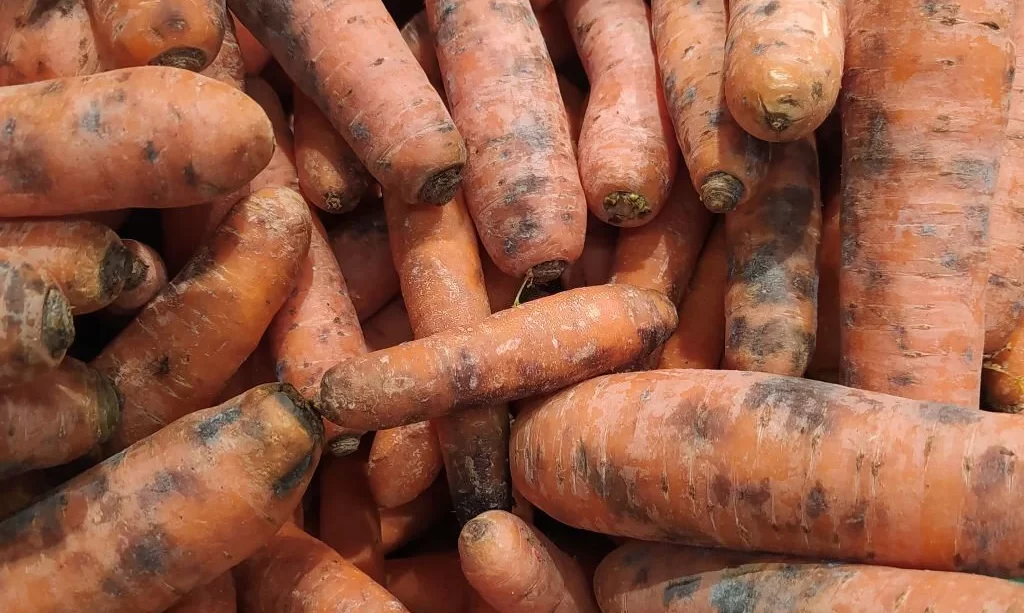Carrots, with their vibrant orange color and crisp texture, are a staple in many kitchens. However, like all fresh produce, carrots can go bad over time, leading to a less-than-pleasant culinary experience and potential health risks. In this article, we’ll guide you through the simple yet essential steps to determine if your carrots have gone bad. Whether you’re a seasoned chef or a home cook, knowing how to spot spoiled carrots is crucial for maintaining the quality and safety of your meals.
Visual Inspection
The first step in determining the freshness of your carrots is to give them a visual once-over. Fresh, healthy carrots should have a vibrant orange color and a smooth, firm texture. Examine them closely, and keep an eye out for any of the following visual clues that your carrots may have gone bad:
- Mold: Check for the presence of mold on the surface of the carrots. Mold can appear as white, green, or black spots and is a clear indicator of spoilage.
- Dark Spots: Inspect the carrots for any dark or discolored areas. These spots can indicate rotting or bacterial growth.
- Slimy Texture: Run your fingers over the carrots’ surface. If they feel slimy or excessively moist, it’s a sign that they have deteriorated and should not be consumed.
By conducting a thorough visual inspection, you can quickly assess the condition of your carrots and determine if they are still suitable for use in your culinary creations.
Smell Test
Once you’ve completed a visual inspection of your carrots, the next step in assessing their freshness is to rely on your sense of smell. Give your carrots a gentle sniff, and pay attention to the aroma. Fresh carrots should have a mild, earthy scent that is pleasant and slightly sweet. However, if you detect any of the following off-putting odors, it’s a clear sign that your carrots may have gone bad:
- Sour Odor: Spoiled carrots can emit a sour, fermented, or unpleasant smell, similar to the smell of vinegar or rotten food.
- Musty Odor: Carrots that have deteriorated may also have a musty or moldy odor, resembling damp, decaying vegetation.
Trust your sense of smell; it’s a valuable tool in determining the edibility of your carrots. If they give off any disagreeable odors, it’s best to discard them to avoid compromising the quality of your dishes.
Touch and Texture
To further confirm the condition of your carrots, it’s time to assess their texture through touch. Gently squeeze or press the carrots between your fingers. Fresh and healthy carrots should feel firm and solid throughout, with a slight resistance to pressure. However, if you notice any of the following texture issues, it may indicate spoilage:
- Softness: Carrots that have gone bad often feel soft, rubbery, or mushy when touched, rather than firm and crisp.
- Wrinkles: Wrinkles or shriveled areas on the surface of the carrots are a sign of dehydration and deterioration.
- Sliminess: A slimy or slick texture is another indicator of spoilage, as it suggests bacterial growth or decay.
By conducting a touch and texture assessment, you can further confirm whether your carrots are still in good condition or if they have reached the end of their shelf life. This tactile evaluation, combined with the visual and smell tests, provides a comprehensive picture of your carrots’ freshness.
Taste Test (Optional)
While it’s not always necessary or recommended to taste carrots to determine their freshness, in some cases, a taste test can confirm suspicions of spoilage. If your carrots pass the visual, smell, and touch tests but you’re still uncertain, you can take a small, cautious nibble. However, be extremely vigilant during this step, as spoiled carrots can have an unpleasant, bitter, or off taste. If you detect any unusual flavors or textures, it’s best to spit out the carrot and discard the rest immediately. Keep in mind that taste testing is optional and should be done with great care to avoid consuming spoiled food.
Storage and Prevention
To maintain the freshness of your carrots and prevent them from going bad prematurely, it’s essential to store them properly. Here are some tips:
- Refrigeration: Store carrots in the vegetable crisper drawer of your refrigerator, preferably in a plastic bag or airtight container. Cold temperatures help slow down the deterioration process.
- Remove Tops: Trim the green tops or foliage from the carrots before storage, as they can draw moisture away from the roots.
- Keep Dry: Moisture can lead to mold and decay, so make sure your carrots are dry before storing them.
- Regular Checkups: Periodically inspect your stored carrots for any signs of spoilage and remove any bad ones promptly to prevent the spread of decay.
Conclusion
In conclusion, being able to tell if carrots have gone bad is an essential skill for any home cook or vegetable enthusiast. By conducting a thorough visual inspection, using your sense of smell, assessing the texture, and optionally performing a taste test with caution, you can confidently determine the freshness of your carrots. Proper storage and preventive measures also play a crucial role in prolonging the shelf life of your carrots. With these guidelines in mind, you can enjoy fresh and delicious carrots in your meals while avoiding any potential health risks associated with spoiled vegetables.



